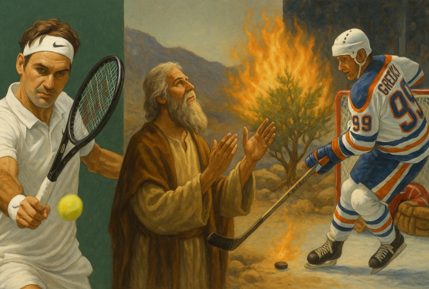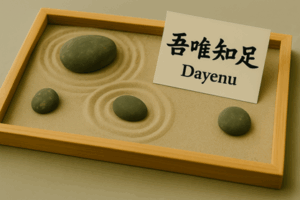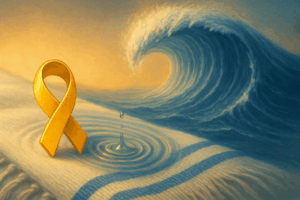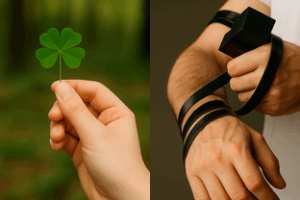Burning, not consumed—
Moses turns aside to see.
Wonder leads to truth.
There is always a first time. For me, it happened on Rosh Hashanah. Joan and I were having dinner at Chabad in Lenox, Massachusetts, on the first night of the holiday. Our table was deeply engaged in conversation about the Torah, Israel, and Jewish meaning. The woman seated next to me, Naomi, asked, “When did you convert to Judaism?”
I was caught off guard. After a pause, I asked, “Why do you think I converted?”
She replied matter-of-factly, “You kept referencing things in Judaism and Torah that you recently learned.”
I smiled and explained, “I was born Jewish, but I never stop learning.”
We both laughed. That moment inspired this reflection on what I call the “Beginner’s Mindset” and the pursuit of lifelong learning.
The Torah gives us the ideal model of a lifelong learner: Moses. His journey begins not with grandeur, but with curiosity. In Exodus 3:2–4, he notices a burning bush. A common sight in the wilderness, yet something prompts Moses to turn aside and look again. That simple act of awareness, of seeing the ordinary in a new light, became his divine awakening.
This transformation reminds me of Wayne Gretzky, who once said that even after scoring 200 points in a season, “I am always learning new things about hockey, and seeing things on the ice I have not seen before.” Like Moses, Gretzky never stopped being a student. Greatness isn’t about final perfection, it’s about continuous learning and determined discovery.
As a lifelong tennis fan, I’ve always found meaning in the backhand. For two tennis greats, Mats Wilander and Roger Federer, the backhand became a tool of transformation.
Mid-career, Wilander added a one-handed slice backhand to complement his two-handed bludgeoning backhand, drawing inspiration from legendary Swede Bjorn Borg. The added variation gave his game unpredictability and helped him win three Grand Slams in 1988, rising to World No. 1.
I’m reminded of my college squash coach who once told me: “If you want to hit your forehand harder, try also hitting it softer.” Contrast, not just power, can disrupt and surprise.
Roger Federer’s backhand, once considered a liability, evolved through precise technical adjustments and a heavier racquet. By striking earlier and higher, he transformed his weakness into a weapon. From 2017–2018, he returned to dominance; not by inventing something new, but by mastering something old.
In Japanese philosophy, 初心忘るべからず (Shoshin wasuru bekarazu) means “Never forget the beginner’s spirit.” 生涯学習 (Shōgai Gakushū) translates to “lifelong learning.” These values, deeply rooted in Zen and Confucian thought, echo Moses’ evolution. He never stopped learning From Hashem, his people, and his own failures; Moses epitomized Shoshin at the top of Mt Sinai.
Later life in, Moses added a new skill. When God called on him to lead, Moses resisted: “I am not a man of words… I am slow of speech and slow of tongue” (Exodus 4:10). A Midrash suggests he burned his tongue as a child. Moses pleaded for Aaron to speak in his place. Yet by Deuteronomy, Moses evolved into the most loquacious leader of the Children of Israel. The hesitant shepherd became the eloquent prophet.
Let’s return to our Rosh Hashanah at the Lenox Chabad. On the second day of Rosh Hashanah, Rabbi Levi honored me with blowing the Shofar and receiving the first Aliyah as a Kohen. At Kiddush afterward, Naomi and I laughed about her assumption the night before. The “convert” became a “Kohen” and was now chanting blessings and sounding the shofar.
May we each have the courage to pause, the curiosity to look again, and the humility to begin anew. May we continue to turn aside, to see, to listen, and to grow. May our “nevers” become ”nows” as we experience new perspectives and learn new skills. I am filled with anticipatory excitement about my next opportunity to say, “There is always a first time. For me, it happened on…” …to be discovered.
Shoshin at Sinai,
Even masters seek to grow—
Fire never fades.
Appendix:
Roger Federer
Grand Slam victories after his backhand evolution
- In 2017, Federer won two Grand Slams: the Australian Open 2017 and the Wimbledon Championships 2017.
- In 2018 he won the Australian Open 2018 (his 20th major).
- His career total is 20 Grand Slam men’s singles titles.
Win‑loss record & ranking
- For the 2017 season: win–loss record of 54–5.
- Career stats: 103 ATP singles titles; Grand Slam singles finals: 20 wins, 11 losses.
- He achieved world No. 1 ranking multiple times, and notably returned to No. 1 in February 2018 at age 36.
Mats Wilander
Grand Slam victories after his one‑handed slice/backhand shift
- According to sources, Wilander “mid‑career, in 1987, developed a highly effective backhand slice.”
- His peak year was 1988 when he reached world No. 1 (12 September 1988).
- He won 7 Grand Slam singles titles total: these include the Australian Open (1983, 1984, 1988), Roland Garros / French Open (1982, 1985, 1988) and the US Open (1988).
Win‑loss record & ranking
- Career high ranking: No. 1 (September 1988) and he finished year‑end No. 1 in 1988.
- Career singles match record: 571 wins – 222 losses.






